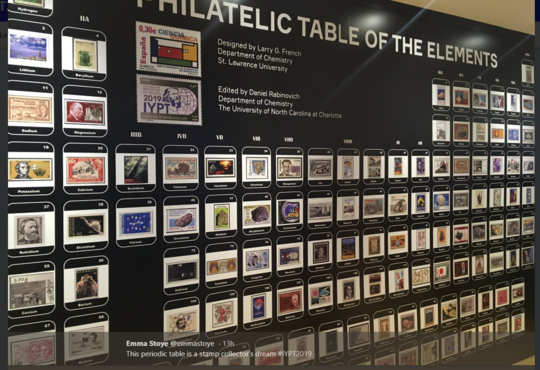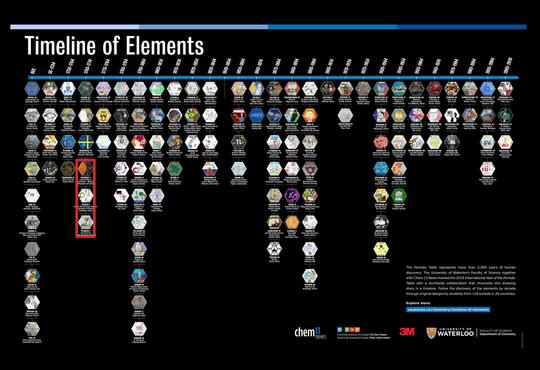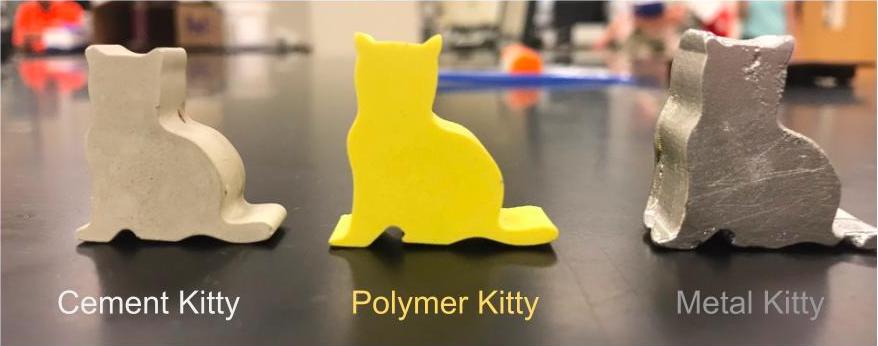
Introduction
Materials science is the study of our material world. It is using knowledge of the structure, bonding and properties of a substance to optimize its performance in a specific function. My interest in materials chemistry has prompted me to attend ASM’s Materials Science Teachers’ Camp1 over the last two summers. After the first year of attending, I slowly began to weave materials science into my grade 11 and grade 12 chemistry courses. Grade 12 was easy for me as teaching IB Chemistry allowed me to teach materials chemistry as an optional unit. Grade 11 was a little bit more of a challenge. However, I’ve learned there are many places to incorporate materials chemistry into chemical bonding.
When teaching chemical bonding, covalent bonding of small molecules and ionic bonding of salts tend to be the areas of focus. The issue with this is that many students think chemistry is restricted to small molecules and table salt, restricting them from pondering the chemistry of everyday objects.
In a simple activity using just one silicone mold, students can create take-home objects that can be used as a springboard to discuss metallic, ionic and covalent bonding present within everyday objects. These objects can be analyzed using the triangle of bonding, empowering students to look at how the chemical bonding of everyday objects leads to the properties of a substance and thus its material function. Following is an analysis of the tin, ceramic (cement) and polymer (Eurocast)2 objects shown in the image above using the triangle of bonding. Instructions for how to make the objects using a silicone baking mold are included afterwards.
Triangle of bonding
As of late I have been trying to introduce the different types of chemical bonding using the van Arkel-Ketelaar triangle of bonding. I learned about the van Arkel-Ketelaar triangular bonding diagram3,4 for the first time as a graduate student in a solid state chemistry class. I find it easy to use, and it clarified all of my speculations about bonding. It is in an optional unit (Materials chemistry section) in the IB curriculum. I teach it when I introduce bonding in grade 11, right from the very first lesson in chemical bonding.
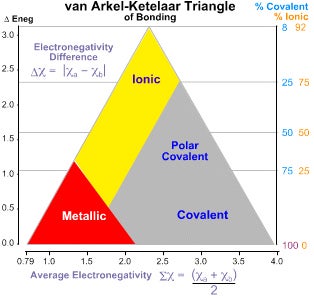 Van Arkel-Ketelaar Triangle3
Van Arkel-Ketelaar Triangle3
[Email Chem 13 News and we will send you Sarah’s Google Slides introducing bonding and the van Arkel-Ketelaar triangular bonding diagram.]
This triangle is a method that utilizes electronegativity values to predict the type of bonding between two different elements. What I like most about the triangle is that it allows bonding to be interpreted as a continuum rather than discrete. The image above is an example of a van Arkel-Ketelaar triangle. This allows metals and metal alloys to be included in the discussion of electronegativity and bonding, along with being a good visual representation of polar covalent bonds being intermediate between pure covalent and ionic.
The objects made using the following procedures are all solids with remarkably different properties: Cement having a high melting point and insulating properties, tin with conductive and malleable properties and the
Eurocast with a low melting point and low density. By considering the elements that comprise the objects, their properties can be analyzed using the triangle of bonding.
Tin, assuming the sample is purely elemental, would be plotted on the bottom right-hand corner of the metallic bonding region. This would give the metal a type of “covalent character,” which would make sense given its p-block location on the periodic table (the region of the periodic table where the non-metals are situated).
Cement is primarily comprised of calcium oxide with silicon dioxide and other additives. Looking at the calcium oxide bond, we can see it would fall in the ionic region. Silicon dioxide, however, would fall in the polar covalent region. This can facilitate the discussion of how, even though the silicon-oxygen bond is polar covalent, it has a network covalent structure, making it compatible with the calcium oxide and contributing to the brittle, insulating, high-melting nature of cement.
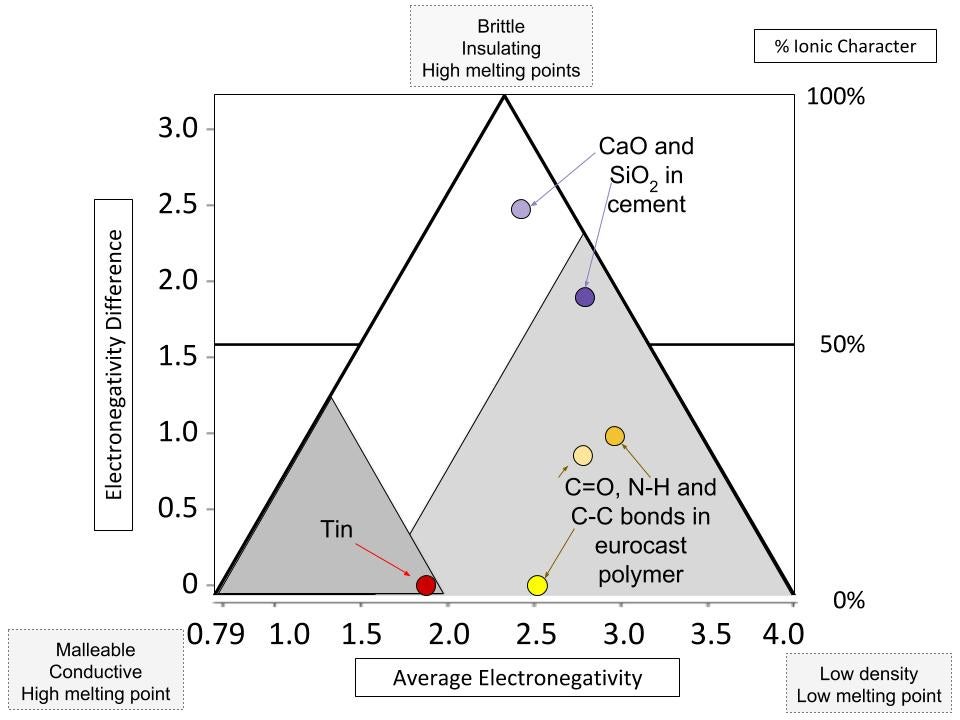 Van Arkel-Ketelaar Triangle with bonding for polymer, cement and metal
Van Arkel-Ketelaar Triangle with bonding for polymer, cement and metal
Eurocast is said to be a polyurethane polymer. By selecting some of the main covalently bonded elements in polyurethane, the N-H, C=O and C-C bonds were plotted onto the triangle. All of these fall within the covalent bonding region, with some located further up into the polar covalent region. These would lead to strong, intermolecular forces between polymer chains, creating a rigid polymer structure (in addition to the cross-links).
Procedures for creating objects
Note — these objects could easily be turned into holiday ornaments by placing a paper clip in the back of the mold while still fluid and adding a string through the paper clip after the object is solidified and cooled. You could even hang it on your classroom chemistree!
Goggles, gloves and lab coats are recommended when working with the hot metals and the Eurocast solutions. Be warned, the plastic colour pigments do not come off easily. With the plastic and cement I cover the tables with garbage bags because it can be difficult to clean off.
Polymer Kitty
Materials
- Almond Eurocast Part A and Part B from IASCO TESCO2
- Plastisol pigment from IASCO TESCO2
- Wooden stir sticks,
- Small disposable cups and disposable pipets
- Silicone baking mold
- Garbage bags
Procedure
- Lay garbage bags onto the working space as a protective coating
- Measure 5 mL of Eurocast Part A into a disposable cup using a disposable pipet
- Measure 5 mL of Eurocast Part B into a different disposable cup using a different disposable pipet
- Add 1-2 drops of plastisol pigment (colour of your choosing) into one of the cups, stir using a wooden stick
- Pour cup containing Part B into the cup containing Part A and stir for 30 seconds
- Fill molds near the edge but do not let run over (fill a second mold if necessary)
- Let sit for 15-20 minutes and remove from mold (should be cool to the touch when ready)
You really just need roughly equal parts of both mixtures. I use the bottom line on the cup wall as an indicator or a certain number of aliquots from a pipet. I wouldn't use a balance or any glassware because I would worry about clean up. My students used approximately 2-5 mL, measuring with the 1 mL markings on the plastic pipets.
Extension
Eurocast is a polyurethane polymer made via condensation polymerization. Polyurethane can be a thermoplastic or thermoset polymer depending on the proportion of reactants (Parts A and B) added. If the reactants are added in equal proportion, the polymer formed is a thermoset polymer. When the ratio deviates from 1:1, a thermoplastic polymer can form. This is apparent when a flexible material is produced. The rigid nature of the thermoset polymer is from the strong, covalently bonded cross-links between polymer chains. The flexible nature of the thermoplastic polymer is due to the fewer cross-links and weaker intermolecular forces (LDFs) between polymer chains. It could be an interesting class activity to analyze the different properties from varying ratios of Part A to Part B.
Metal Kitty
Materials
- Hot pot 2 melter from IASCO TESCO5
- Magic sand/kinetic sand and muffin baking tray
- Tin nuggets from Metal Shipper6
- Tweezers
Procedure
- Fill a muffin baking tray with magic sand (must be an oil coated sand so it will keep an impression when it is pressed in). Ensure it is tightly packed.
- Press the Eurocast polymer object (created in last procedure) firmly into the magic sand to make a mold impression where you will be pouring molten tin.
- Remove the Eurocast object carefully, using tweezers if needed, leaving an impression of the mold.
- Heat 1-2 nuggets of tin until molten in the hot pot melter.
- Carefully pour the molten tin into the sand mold.
- Let sit for approximately 30 minutes and then remove from mold (approach with hands slowly and ensure it is cool to the touch).
Safety
Ensure to keep all water away from molten metal. Even the smallest drop of water can cause rapid evaporation, splashing the molten metal. Ensure sand is completely dry (magic sand feels wet because of the oil present).
Extension
Since lead is also a low melting metal, students could make lead-tin alloys of varying lead to tin ratios. Students could study various properties including their conductivity and melting points. The varying cation size in the metallic lattice should result in a less malleable material with a lower melting point from the weaker metallic bonds.
Ceramic Kitty
Materials
- Mold Release Spray - Camie 980 from IASCO TESCO2
- Rapid set cement
- Silicone baking mold
- Water
- Small disposable cups and wooden stir sticks
Procedure
- In a well ventilated area, spray silicone baking mold with the mold release spray
- In a disposable cup, measure approximately 40 mL of cement powder and 50 - 60 mL of water
- Stir using a wooden stir stick, consistency should be that of pancake batter
- If mixture is too thick, add increments of 5 mL of water, if mixture is too thin add small scoops of cement until desired consistency is reached
- Fill molds near the edge but do not let run over (fill a second mold if necessary)
- Let sit overnight and remove from mold (should be cool to the touch when ready)
Extension
Students could vary cement-to-water ratios to deduce which ratio produces a material with the most desirable properties. Alternatively, students could investigate what happens if the water used is increasingly more acidic (a large component of cement is the basic Ca(OH)2 and CaO). Students could also investigate change in properties by adding small pebbles to create a composite material.
Solids made up of metals, ceramics and polymers make up a significant portion of our physical world. As chemistry teachers it is our responsibility to engage students in the chemistry of the world around us, including our material world. Giving student experiences with tangible objects that they themselves created is a way to engage students and help them visualize the chemistry all around them. Using the triangle of bonding, students can perform a rigorous analysis of the electronegativity of elements, bonding and properties of resultant materials.
Teachers interested in Materials Chemistry should attend an ASM Teachers’ Camp, which offers incredible professional development and adds to any chemistry program. I attended my first one in Philadelphia, and did the second part in Ann Arbor. I plan to volunteer at the camp this year in Hamilton. They do university research tours, send you home with great resources and materials, along with bringing together driven teachers. Over 30 cities across North America offer ASM Teachers’ Camps.1
References and notes
(Online references accessed February 2019)
- ASM Materials Science Education Foundation. Teachers’ Materials Camp and more information on this activity.
- I purchased a gallon of Almond Eurocast Part A and B from IASCO TESCO. For 50 students, I used ¼ gallon. It is easy to order everything over the phone or through e-mail. It was quite difficult to navigate their catalogue because it does not have a search engine and it is massive. They will send a physical copy if you prefer, which is much easier to sift through. I had my shipment to Canada in a few weeks. They are friendly and easy to work with.
- W. B. Jensen, A Quantitative van Arkel Diagram. Journal of Chemical Education, 1995, 72 (5), 395-398.
- M.R. Leach, Tetrahedra of Structure, Bonding & Material Type. The Chemogenesis Web Book, 1999-2018
- The hot pot was very easy to use and quite small. $39.95 USD (on page 138 of the 2018 catalogue)
- Purchased from Metal Shipper. www.metalshipper.com



